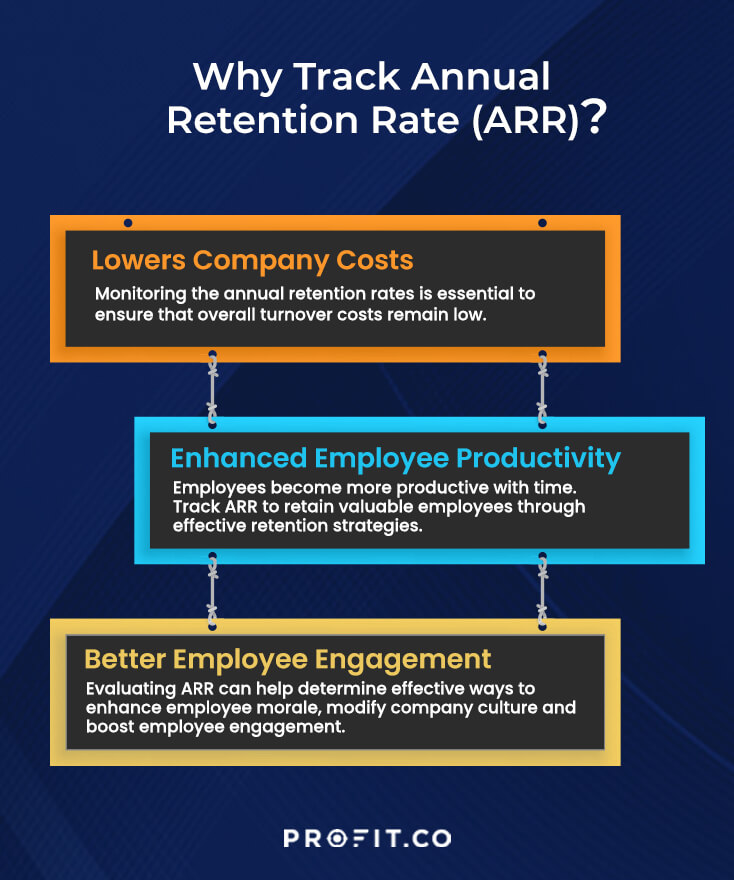In the current competitive market, employee retention is an essential aspect. Losing valuable employees with specialized and high-demand skills is expensive in terms of time and money.
Hiring and training new employees is an additional cost that can affect production and business. It’s easier to address the issues that cause employees to depart. The Annual Retention rate (ARR) helps determine your HR program’s effectiveness, and it’s easier to modify your strategies to retain top talent. Let’s discuss the annual retention rate, why it matters, calculation methods, and how to improve your retention rates.
What is the Annual Retention Rate (ARR)?
The annual retention rate determines the number of employees you retain in one year. It’s a ratio of current employees and the number of employees in the same positions at a previous time. The ARR gives you a clear picture of the employee satisfaction rate and your ability to sustain an efficient workforce.
A high rate shows that your team enjoys working with your company and your culture and gets fair compensation. A low retention rate shows that some crucial elements are missing or unsatisfactory. Understanding this will help you re-evaluate your retention rates since you can monitor whether your rates will improve.
OKR Software is your ultimate solution when it comes to ARR as it allows you to track your strategy in real-time to improve employee engagement. You can get started on Profit.co completely free today!
Definition and Example
The employee retention rate is the total number of employees that remain with your company over a certain period. It compares the number of employees at the beginning of a given period to the number still present at the end.
You can calculate the retention rate on a quarterly or annual basis. For example, let’s say your company had 200 employees on 1st January 2021 and 175 employees on 31st December 2021. You can use these numbers to determine your annual retention rate.
If you had 25 employees on 1st July but 20 employees on 30th September, you can calculate the retention rate for the third quarter.
Calculation
Calculating your employee retention rate is a relatively simple process. You’ll divide the total number of employees present on the last day of a given period by the total number working on the first day. Specifying the timeframe for your calculations is essential, and outlining a timeline makes it easy to compare the figures to future data within a similar timeframe.
Annual Retention Rate Formula
There are different formulas you can use, but the retention rate formula is:
Let’s say you started the year with 70 employees but had 50 employees at the end of the year. Your retention rate will be:
(50 / 70) x 100 = 71.42
So, in this Annual Retention Rate Example, the rate is about 71%
How Do You Calculate the Annual Retention Rate?
You can calculate your annual retention rate by following these guidelines:
- Specify the Period
- Conduct a Headcount
- Deduct
- Divide
- Evaluate
The first step is determining a particular timeframe you want to measure. For annual rates, you can use the calendar year (1st January to 31st December of a year ) or the fiscal year (1st October of one year to 30th September of the following year)
Next, you’ll need to count the employees working with you on the particular day your year starts. This excludes those employees who joined your team at any point within the year.
Once you determine the total number of employees you had, you can calculate those who left during the year. You’ll deduct the number of original employees left at the end of the year from the number you got in the headcount.
This value will help you calculate the percentage rate.
The next step is dividing the remaining employees by the original employees at the beginning of the year. This decimal value is your actual employee retention rate, which you can multiply by 100 to get a percentage.
The retention rate value (%) helps you determine whether your company has a healthy retention rate. If your numbers are near 50% or below, you need to reconsider your HR department’s strategies for employee retention.

Employee Retention vs. Turnover Rate
The employee retention rate goes hand in hand with the employee turnover rate. These two values represent opposite situations but give a more detailed picture when used together.
As discussed above, employee retention is the rate your company keeps employees. However, the employee turnover rate measures the employees leaving your company voluntarily or involuntarily.
- Voluntary turnover happens when employees leave the company due to dissatisfaction or better opportunities.
- Involuntary turnover occurs when the company terminates an employee due to performance issues or staff reductions.
The employee turnover rate is the same as the churn or attrition rate.
Always treat your employees exactly as you want them to treat your best customers.
Importance of Calculating ARR
One of the most valuable assets in any company is talent. It is crucial for your success because, without helpful employees, you have no tools to help you achieve your business goals.
The best way to ensure an effective workforce is by adopting sound retention strategies. Proper retention strategies will result in:
- Lower production costs
- Better, inclusive workplace culture
- High productivity levels
- Enhanced customer experience
- Robust teams with skilled, talented, and experienced employees
- Enhanced employee morale
Calculating your annual retention rate is the only way to determine your retention strategies’ effectiveness.
3 Reasons to Track ARR
Any business or company requires a healthy employee retention rate to increase the ROI and cut costs. Although employee turnover is unavoidable, your response to unnecessary turnover and how you mitigate it is what counts.
Here are the top three reasons why you need to track your ARR:
1. Lower Company Costs
Studies show that losing one employee costs a company a third of the person’s annual salary. Replacing that employee costs about 6 to 9 months of their salary, and we haven’t considered the effects on production.
Therefore, monitoring your annual retention rates is essential to ensure your overall turnover costs remain low.
2. Enhanced Employee Productivity
Employees who remain with your company become more productive with time. A top-performing employee is worth about ten to a hundred times their salary each year they stay at their job.
Your company’s best interest is to retain valuable employees through effective retention strategies.
3. Better Employee Engagement
Evaluating your annual retention rate can help you determine effective ways to enhance employee morale, modify your company culture and boost employee engagement.
Two Key Reasons for Employee Turnover and How You to Improve ARR
There are numerous reasons why employees leave their positions, but the two most common ones are:
- Lack of growth opportunities
- Burnout
1. Employee Burnout
One of the leading causes of high turnover rates is employee burnout. Overworking employees with work makes them burned out and stressed, driving them to quit. Alternatively, they’ll actively look for workplaces that allow a work-life balance that suits their lifestyle, needs, and preferences.
The Solution
You can reduce employee turnover and help your team manage stress by re-evaluating the work scope distribution.
- Ensure there’s reasonable work distribution across the entire company. You can start monitoring individual and team tasks to ensure a balance.
- Consider hiring additional staff if your employees feel overworked
- Conduct employee surveys to understand when teams are near burnout
2. Lack of Growth Opportunities
Employees naturally seek and work towards career growth or advancement. Besides financial motivation, professional development is essential to ensure personal fulfillment.
Angela Simpson, an HR advisor at the Society for Human Resource Management, shares some valuable insights into this aspect.
She highlights that employers must create new opportunities within the company that utilizes the team’s other strengths. Keeping things interesting will prevent your employees from looking for growth opportunities elsewhere.
The Solution
The best way to address this challenge is by adopting professional development programs.
- Start various mentorship and training programs to help employees develop clear career paths. It helps to encourage your team to participate in related conferences proactively.
- Adopt new tech innovations to help your employees achieve professional goals and drive growth
FAQs
1. How Do the Retention Rate and the Turnover Rate Relate?
The retention rate is the opposite of the turnover rate in your company. For example, if your retention rate is 90%, your turnover rate will be the remaining 10%.
2. How Often is It Necessary to Calculate Retention Rates?
Most companies calculate employee retention rates annually; your one-year period can be the fiscal or calendar year. If your retention rates are significantly low, it’s best to calculate them regularly, such as every quarter.
It’s the best way to ensure continuous improvement and monitor the effectiveness of your new strategies.
3. Why is Employee Turnover a Concern?
Employee turnover is a significant challenge for most companies as it directly affects profits and growth. Onboarding a new employee is often expensive, so you can use these funds to enhance your current employees’ satisfaction.
Conclusion
The success of your business or company largely depends on retaining your top talent. Long-term employees will help you innovate, achieve and accomplish individual, team, and company goals. However you may have the most fabulous retention plan, but if your employees fail to resonate, it becomes pointless. It’s, therefore, essential to monitor your strategies to ensure they are working.
Profit.co OKR Software is your ultimate solution when it comes to ARR. It aims to transform your business by focusing on your objectives and metrics to track them. This innovative software ensures real-time progress updates and notifications you can access on any device.
You can encourage employee engagement through OKRs and dynamic project management. Schedule a free demo today and discover new success levels for your business.

